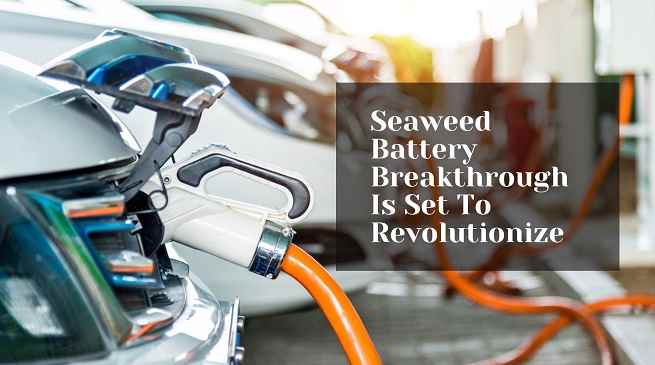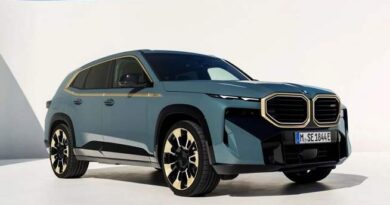SURPRISE Seaweed Battery Breakthrough Is Set To Revolutionize The Entire EV Industry
SURPRISE Seaweed Battery Breakthrough Is Set To Revolutionize The Entire EV Industry
Several marine nations rely on them for the food industry and fertilizer. These plants are mostly used as food in Asia, especially in Japan, Korea, and China.
In some regions, growing seaweed has developed into a significant economic activity. However, consuming both plants and animals is limited in most developed nations.
And not much emphasis has been placed on learning how to cultivate seaweed either. Today, seaweeds might be used for a wide variety of practical purposes.

Right now, most industrial applications are limited to Phycocholoid extraction and a much lesser degree, the extraction of a few fine biochemicals.
It’s also currently not possible to ferment or pyrolyze on a commercial basis.
Nonetheless, these are viable choices in the 21st century. However, recently we’ve discovered that seaweeds can also be utilized in the energy and transportation industry.
That’s exactly what we’re going to talk about in this video. Hey guys, welcome back. Make sure to click the like button below and subscribe to Tech Revolution.
Now let’s begin. In foods such as ice cream, seaweed derivatives are employed as a thickening agent and used in the pharmaceutical sector.
Seaweed cells may soon power our smartphones, cars, and homes. And, even after a thousand charges, it remains functional.
A recent study out of the United Kingdom suggests that seaweed-based batteries might pave the way toward more environmentally friendly storage options.
As it turns out, seaweed is not only a superfood but also a super industrial chemical. Now, in 1811, the essential ingredient iodine was discovered in seaweed.
Moreover, iodine is abundant in seaweeds, especially S japonica. In certain varieties, B twelve is present in rather high concentrations.
In addition, the insoluble alginates and fibrous cellulose found in seaweed typically include minerals including calcium, iron, magnesium, sodium, or salts of alginic acid.
In the second week of October, researchers said they had found promising results from a battery chemistry investigation utilizing a layer made from seaweed.
That might potentially open the door for more reliable and secure methods of energy storage.
The research, which was published in the journal Advanced Materials, details how seaweed extract may be used to create stiff separator fibers.
These fibers have the potential to enhance battery performance by preventing sodium electrode crystals from penetrating the separator.
So a separator is a component of a battery that physically divides the battery into its active components.
In addition, the charge must move freely. A critical component of any future battery chemistry or form factor is the adoption of a strong, flexible, and relatively thin separator material, or nanostructure.
Now, if you’ve been watching our previous videos, you might probably already know that lithium-ion batteries have a lot of drawbacks.
In modern times, lithium has found its way into nearly all portable electronic devices. And because of this, lithium is in limited supply.
Sometimes lithium is refined in ways that are harmful to the environment. In addition, the people who mine it aren’t paid enough to live a decent life.
According to Benchmark Mineral Intelligence, the price of lithium increased by 478 1% between January 2021 and January 2022, and lithium scarcity is predicted to get even worse.
Since their invention in 1980 by John Good enough, lithium-ion batteries have been widely adopted, despite being neither the best nor the safest option.
Moreover, they are also a potential fire hazard. There have been at least two recorded fires with Tesla megapack batteries, with one occurring in Australia in July 2021. And on September 20, 2022, another event was reported in California.
Sodium metal batteries
Now available as a safer alternative, and for the next round of massive projects, they are the most promising source of cheap high-energy power storage.
However, there is a major issue with SMBs. Dendrites grow uncontrollably in SMBs, which causes the separator to be pierced, leading to a short circuit in rapid battery depletion.
Lithium-ion is advantageous since it has one of the highest energy densities of any existing battery technology.
Also, the voltage that lies ion cells can produce is up to three 6 volts, which is three times as much as that produced by other battery chemistries.
Researchers also demonstrated that seaweed-based materials are capable of providing sufficient strength for the separator.
That would protect it from the sodium dendrites that form after several charged discharge cycles.
So what exactly is the future of seaweed-based batteries now? One advantage is a larger storage capacity.
According to researchers in the UK, the nanostructure of the seaweed-based battery reportedly permits increased storage capacity and efficiency.
Also, this may allow them to extend the battery’s useful life. These batteries may also allow electric vehicles to go far further.
Coauthor and creator of the Cellulose Nanomaterials, Dr. Amaka Onianta of the BCI, weighed in on this as well.
She expressed her joy at the prospect of using these nanomaterials to fortify the separator components.
She’s also pleased that their efforts have facilitated a global shift towards sodium-based batteries.
Furthermore, she added that this would eliminate the need for resources like lithium that are in short supply.
Moreover, this material is frequently mined in a way that doesn’t respect the environment, and the process consumes a lot of water.
The study’s principal investigator and BCI professor, Steve Acorn provided some insight as well. He emphasized the importance of this study, improving the feasibility of cleaner energy storage methods.
He said this technology has the potential to be effective without causing any harm to the natural world during its manufacture.
Can a battery ever be made without using lithium metal?
That isn’t the first time that lithium-free batteries have been studied.
In 2010, an international group of researchers led by those from the United States and Saudi Arabia announced the development of a new lithium metal-free battery.
Theoretically, this battery can deliver 1550 watt-hours per kilogram of mass, and compared to modern lithium-ion batteries, these represent a factor of four improvements.
Four individuals from the Materials Science and Engineering Department served as the team’s leaders. There was also one from the applied physics division at California Stanford University.
The results of the study were eventually published in the ACS journal Nano Letters.
Now the team of scientists believes they have found a solution to the problems plaguing lithium-ion batteries with their design.
And this entails things like a lack of electrical conductivity instability and volume expansion. And in 2017, Berkeley Laboratory presented a similar concept for seaweed batteries.
It found that carrageenin, a byproduct of red seaweed, may stabilize a lithium-sulfur battery, making it more widely used.
The sulfur is prevented from dissolving thanks to a reaction between the seaweed derivative and the sulfur. And ultimately, they hope to manufacture cells that can withstand thousands of charging cycles, making them superior to many common batteries.
However, the group said it needs to learn more about the derivatives’ relationship with sulfur.
They also want to know if there is a way to undo it if sometimes goes wrong.
The next hurdle for this new series battery by UK scientists is figuring out how to mass produce batteries at a rate of hundreds of gigawatt hours per year.
Furthermore, they need to learn how to fulfill the world’s unquenchable need for mobility. And we probably might not see this battery in the next ten years.
If seaweed batteries live up to their potential, they might help relieve some of the strain placed on current lithium-based alternatives.
In extreme cases, we may even just replace it. So guys, what do you think of this sustainable new battery technology?
Let me know what you think in the comments section below.
Related Post



